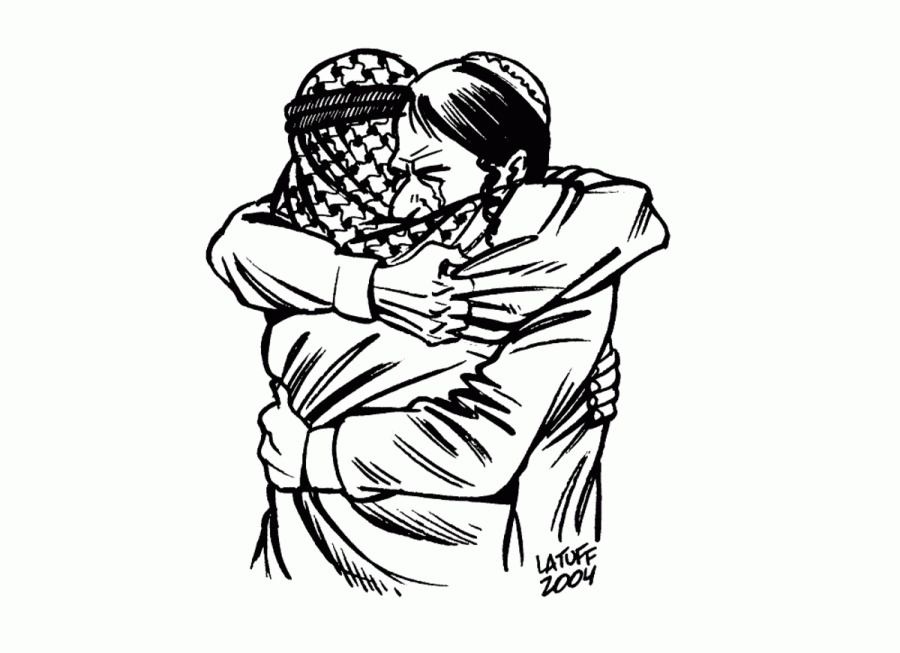After standing up to Goliath, has David become a bully?
The Jews have encountered and survived, with incredibly dignity and resilience, a gauntlet of oppressive forces: the pharaohs of Egypt, Nebuchadnezzar, Queen Isabella and King Ferdinand’s Inquisition, the pogroms of the Russian Empire and the unspeakable horrors of the Nazi régime. Following the events of World War II, the Jews were given their own sovereign state carved from British-controlled Mandatory Palestine, where they could be safe.
In South Florida, a thriving Jewish community keeps strong ties to this State of Israel. Since the brutal murder of three Israeli teenagers at the hands of suspected Hamas militants, my Twitter and Facebook feeds have been flooded with students reposting articles that glorify the Israel Defense Force’s (IDF) Gazan campaign and affirm Israel’s right to retaliate. Such materials have but spared the usual, overgeneralized polemics that demonize an entire nation of Palestinians into caricatures of blind hatred.
To clarify: Israel is a sovereign state. Therefore, it has every right to its self-defense. As President Obama pointed out, any country would agree if bombarded with missiles in their backyards.
Many Jewish-Americans and Israelis maintain that the IDF must forcefully intervene in Hamas-controlled Gaza to protect Israeli civilians from vengeful rocket barrages. Hamas, a terrorist organization by most international standards, has vocally called for the destruction of the State of Israel. Hamas, then, is the problem. Right?
Yes, but not entirely.
The Gazan conflict is not a simple case of Israeli good guys fighting the Palestinian bad guys. Of course, Hamas is a proven terrorist organization concerned more with rockets and missiles than the welfare of constituent Gazans. But terrorism is ultimately a matter of perspective: one man’s terrorist is another man’s freedom fighter. And recent statistics published by Israeli human rights organization B’Tselem indicate that in the eyes of Palestinian civilians, the IDF are no saviors.
B’Tselem’s figures call into question the extent of “self-defense” in an Israeli context: surely, a euphemism. Vox’s Max Fisher did a wonderful job of interpreting B’Tselem’s data. To quote, crucially: “Since 2005, 23 out of 24 deaths have been Palestinian.” This finding is shocking considering Israelis outnumber Palestinians roughly two to one. Separate offices—both from the U.N.—estimate that in Gaza, civilian deaths, including children, account for more than 70 percent of all casualties. And prior to the Israeli ground invasions, which claimed several more lives, the respective death count for Palestinians and Israelis after 10 days of fighting was a lopsided 235 to one. The Israeli ambassador to the U.S., Ron Dermer, cited such figures as rules of war—in contrast to clear U.N. legislation regarding civilian deaths.
However, the statistics do not tell the full story. Part of the reason why these figures are so high are because Hamas, which controls Gaza, fires rockets from schools and stadiums, forcing the IDF to also attack Hamas’ human shields: civilians. Also accounting for the remarkably low number of Israeli casualties is the new Iron Dome missile interception system, which has proven to be remarkably effective in defending Israeli cities.
Yet the disparity of deaths shows that the IDF ground invasion is an unnecessary exercise in disproportionate aggression, given the familiarities of the situation. Hamas are dangerous and cynical in their approach: by stocking their arsenal in mosques and hospitals and subjecting innocent Palestinians to harm’s way, Hamas have coldly gambled that a rising death count will result in increasing international condemnation of Israel. With Hamas’ trap set, the Israeli approach of fighting fire with fire has only burned Palestinian civilians.
Airstrikes, too, have proven a lethal alternative to engaging Hamas. While the IDF claims that it offers warnings for Gazans to evacuate, harrowing B’Tselem accounts show that in crowded urban areas, there is not enough space to avoid death from above. Nor is there enough time to evacuate between warnings, leaving a backdrop of rubble. In this cruel diorama are Palestinian parents, cradling their innocent children, all bloodied and horribly disfigured by IDF bombs.
In a conflict that brewed over the murder of teenagers, website Count the Kids (compiled from various sources, including B’Tselem) reports that in 2014, there have been 162 Palestinian children killed per two Israeli children. If these children are not terrorists or militants themselves, their deaths and the tragedy of the conflict as a whole raise an uncomfortable question: are Palestinian lives not as valuable as Israeli lives?
Unfortunately, this is not the first time such a question has been asked. The situation is farcically familiar, even if certain circumstances have changed since the last penetration into Gaza. For example, the State of Palestine is now a non-member observer state of the U.N., and Egypt has ousted the Hamas-friendly Mohamed Morsi (Hamas began as an offshoot of the Muslim Brotherhood) from the presidency. In addition, Israeli settlers have continued to defy international law by colonizing the West Bank with impunity, which has hurt the process of achieving meaningful peace through a two-state solution. The U.S. diplomatic team, spearheaded by Secretary of State, John Kerry, has failed to reach any meaningful accords. And so once again, innocent Israelis and Palestinians have found themselves ensnared in a vicious loop.
With Hamas unwilling to back down or negotiate, and Palestinian leadership divided, Israel needs to act with proactivity and initiative in order to establish an agreeable legacy for the region—easier said than done. Instead of an unnecessary ground invasion or airstrikes that will only see a bloodbath of Palestinians before an inevitable status quo antebellum, Israel must focus on peaceful solutions. It needs to pursue a ceasefire, as each rocket fired and each Palestinian killed continually dwindles the status of Palestinian President Mahmoud Abbas. Mr. Abbas has been one of the more vocal advocates for a peaceful two-state solution, but has found his clout deflated in the midst of the conflict.
In order to curb Hamas’ deadly regional influence, newspaper Haaretz, in a series of editorials, notes that Prime Minister Benjamin Netanyahu must empower Mr. Abbas, who was already politically weakened when Israel failed to recognize his unity government. The issue of West Bank settlements, a source of chagrin for many Palestinians, has to be addressed as well. And Israel, which must shoulder some of the blame in the conflict, also needs to accept that its “cutting the grass” approach is ineffective for prioritizing military action over peace.
Israeli politics demands politicians who are willing to take bigger risks in the name of peace. Mr. Netanyahu, in an interview with The Atlantic, has admitted that he no longer believes in the two-state solution. Such defeatist rhetoric will do little to inspire any tangible efforts at making peace, and will only encourage more Gazan lawn mowing—and casualties.
Nevertheless, Israel cannot establish lasting peace on its own. It will need its neighbors Egypt and Jordan to step up and be prepared to share responsibilities in reaching a satisfactory solution, and one that reasonably contains the threat of radical Islamism. Israel must also be wary of other regional actors such as Turkey and Qatar, whose disillusionment with the new Egyptian government could jeopardize ceasefire talks. Should a two-state solution prove to be unfeasible, a three-state solution with Egypt and Jordan may prove to be a last hope.
Hope is running out for the Palestinians, whose disenchantment grows with the death tolls. The aging Mr. Abbas will not be permanently available, and as he and his colleagues fade behind the crescendo of rocket fire, former Princeton professor Daoud Kuttab points out that Israel will have to deal with a younger, potentially angrier generation of Palestinian politicians. This is a generation that will have grown up under military occupations and invasions, and that will carry their ancestors’ memories of 1948.
But until a satisfactory solution is achieved, innocent Israelis and Palestinians will find themselves surrounded by lethal rockets, gunfire and finger-pointing as Hamas provocateurs and hawkish Israeli forces duke it out in a dangerous civilian arena. The world will watch and wonder if this will not be the last time that Hamas fires rockets or that Israel incurs into Gaza. Without peace, disenfranchised Palestinians living in Israeli bantustans under Hamas’ terrorist rule will clench fists. With these clenched fists, Palestinians will throw stones at the physical and metaphorical walls that enclose them. Will the Palestinians go the way of the American Indian, who resisted encroaching, land-stealing colonists with stones, bows and arrows?


